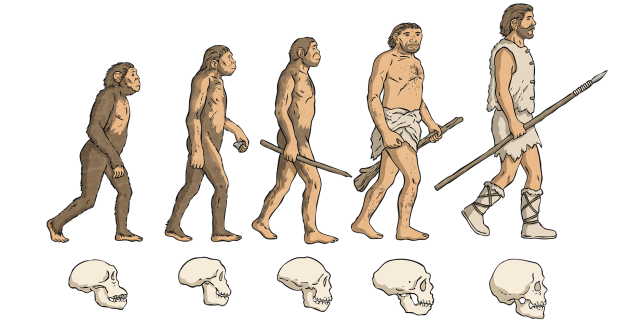
What kind of information will you get from this blog?
- How was life origin on the earth?
- what do you understand about evolution of mankind?
- How was the primitive environment created?
- How was the primitive hydrosphere created?
A very precise sequence of events gave rise to the life supporting systems mentioned in the previous section. Then came the first ever self multiplying organisms on the scene, the blue-green algae. These components of the biosphere then interacted with each other. They grew in complexities and modified each other's properties and composition. Finally, an equilibrium condition was obtained where every thing was in a fine balance supporting each other. All this did not happen in a day. It took more than 3.7 billion years to reach to the presennt stage of evolution of the biosphere. Let us have a broad look at the major events in the process of evolution of life on Earth.
Formation of primitive atmosphere
To begin with when the differentiation of Earth started, there was no atmosphere. In the process of differentiation, as the light elements rose up, the very light elements, which were present in gaseous form bubbled out of the surface of molten Earth and formed the primitive atmosphere. The primitive atmosphere was very thin and had only nitrogen, hydrogen, carbon dioxide and water vapour. It had no oxygen in the beginning.
Formation of primitive hydrosphere
As the outer surface of the molten Earth cooled and solidfied to form a thin crust, it was repeatedly hit and punctured by falling meteorites. Since the atmosphere at that time was very much rarefied, it could not offer any resistance to the falling meteorites and they hit the crust with great force, creating vents in it. Through these vents magma flew out, got solidified and became part of the crust. In this process some gases were also released mainly due to the docomposition of hydrated minerals in the molten rocks.
These gases enriched the atmosphere. The water vapour in this primitive atmosphere got condensed and formed clouds. The clouds then came down in the from of rains. The rainwater on one hand speeded up the process of cooling of Earth on the other hand it filled up the low lying areas and formed the oceans.
Origin of life on earth
As more and more gases were added to the atmosphere it became gradually denser. The clouds, as they moved, got charged and electric discharge between them resulted in thunderstorms and lightening. The lightening fused the elements of the primitive atmosphere into complex compounds. These compounds were then washed down by heavy rains and sent to oceans. In the oceans, under suitable circumstances more and more complex molecules like carbohydrates and amino acids were developed. With passing time more and more complex molecules came into existence which could utilize the energy and materials from their environment. Finally, in the oceans appeared a complex structure which could prepare its own food, using carbon dioxide from air and water from occean, in presence of sunlight. This was the blue-green algae, the first living organisms that ever originated on Earth. It had two properties markedly different from the existing materials-- self growth and self propagation. These are clearly the properties of living beings
Evolution of higher life earth
When the blue green algae appeared in oceans, atmosphere had only nitrogen, hydrogen. water vapours and carbon dioxide. There was no oxygen in atmosphere. And this was good, because the algae could have easily got oxidised in an oxygen rich environment. Then the possibility of life on Earth would have been wiped out. But fortunately the oxygen in air was added at a very slow pace so that the growing life forms could adjust with it.
The algae as they prepared their food through photosynthesis used carbon dioxide and evolved oxygen. But nature had a provision to remove this extra oxygen in the beginning years of evolving life. The iron dissolved in oceans consumed the oxygen exhaled by algae and got oxidised. 2000 to 3500 million year old deposits of iron stones at the bottom of oceans are evidences of this proposition. The early forms of life thus survived and developed into more advanced organisms.
During this period (2000 to 3500 million years from now) however the content of carbon dioxide in atmosphere decreased and that of oxygen increased gradually. The increasing level of oxygen accelerated the process of evolution of life in two ways.
(i) The new organisms adjusted themselves to have greater tolerence for oxygen and to utilise it for more efficient metabolic processes.
(ii) Some of the oxygen formed ozone layer to protect the living organisms from harmful ultraviolet radiations.
On the other hand reduction in the level of carbon dioxide reduced the green house effect, because of which the temperature on Earth could settle down to values more favourable for higher forms of life.
Under these conditions more advanced forms of life evolved which could survive even on land. Around 600 million years ago the environmental conditions and composition of atmosphere became almost similar to the present status. The organisms of the time also had reached a level of evolution to develop into more advanced life forms. The diverse life forms that we see around us today is a result of the evolutionary process of these 600 million years.
Evolution of man
Man also has his place in the story of the evolution of life. Scientists now believe that apes (like Chimpanzee and gorilla) were the ancestors of modern man. On the basis of fossil remains from various excavation sites they have developed a chain of successive stages of evolution of man.

conclusion
From this blog we get information about how environment and human life have developed on earth according to the time.
Do you dream of turning your thoughts and words into income ? join us now and become blogger now.
Some related questions .
1. What is evolution, and why is it consideration a fundamental idea in biology?
Answer: Evolution is the system of alternate in all types of lifestyles over generations. It's fundamental to biology because it provide infromation how species adapt and diversify through the time, providing a details to understand harmony and variety of lifestyles on Earth.
2. what are the difference between natural choice and artificial choice?
Answer: Natural choice is the technique by means of which organisms with traits high-quality for their environment generally tend to survive and reproduce more, passing those traits to their offspring. Artificial choice is a comparable process, but it's pushed with the aid of human choice, such as in breeding packages for domesticated animals or vegetation.
3. How does the fossil details make a help us to understanding of evolution?
Answer: The fossil record is a group of preserved stays or lines of organisms from the beyond. It provide proof of the lifestyles on Earth, showing the emergence of recent species, the extinction of others, and the sluggish adjustments in the characteristics of organisms through the time.

What role do mutations play in the evolution?
Mutations are random changes in the DNA sequence of an organism. They provide the raw material for evolution by way of introducing genetic variation. Natural choice acts on this alteration, main to the improvement of new traits and the model of populations to their environments.
how does variation relate to the theory of evolution?
Adaptation is the method using which organisms grow to be better suitable to their surroundings through the years. The evolutionary principle explains that traits useful for survival and reproduction are much more likely to be surpassed directly by destiny generations through herbal selection, leading to the adaptation of populations to their environment.